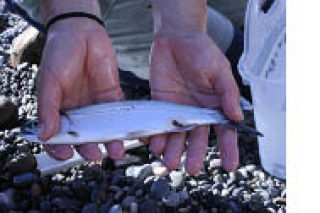Juvenile cutthroat salmon prepped for measuring and identification.
Making fish throw up doesn’t sound like an exciting start to the day, but if you’re as devoted to marine biology as Russel Barsh and his team, you make it your passion.
“We do lavage the salmon’s stomachs, but there’s a reason for that,” Barsh said. “We’re trying to find out exactly what the salmon are eating, when, and where. If we can do that, we can show not only what the salmon are eating, but where the salmon are feeding.”
Barsh and his team of scientists and volunteers are doing this for good reason. In a 2001 report the Washington State Conservation Commission issued a final word on what the area needs to do in order to get the salmon back. The report stated that “there is no salmon habitat in San Juan county.” Barsh believes that is an incorrect statement.
The Kwiaht team uses seining nets in areas around the islands in order to collect salmon and other juvenile fish. They then tag the fish and carefully lavage out their bellies to study the contents of their stomachs. This tells the scientists what the fish are here for. The team found that, this summer, the salmon collected were divided between three kinds of diets. Some of them ate fish (if they were small enough to get into their mouths) like herring and greenling. They also went after amphipods (sand fleas) and larval crab (about the size of a lentil) and insects.
“The interesting thing to us is that by mid-summer, insects are a fall back resource for fish who can’t catch other fish. It becomes a land and sea equation,” Barsh said. “If the salmon can’t get fish, then it will eat insects. 50% of salmon this summer were eating fish. 10% last year were eating fish so the salmon were doing better this year in terms of acquiring fish.”
The big message is that salmon feed on smelt, sandlance, herring. These are the three favorites. But coastal wetlands and lagoons are imperative in the lifecycle of salmon because these areas produce swarms of flies and termites that the salmon feed on as well.
“Most of the crustaceans have reproduced and there isn’t much in the water besides small fish and insects at the end of summer,” Barsh commented.
The philosophy behind Barsh’s work is that the islands are a very important stop in the lifecycle of Puget sound salmon. When Barsh started his study, amazingly, there were still doubts as to whether the islands played any role at all in salmon production.
“All the focus was on rivers, deltas, and the mainland. We began to press the idea that we had seen juvenile salmon along the shorelines and we hypothesized that this was a lunch stop on the way out to the ocean.”
“Yes, we are at the point where we can say that every salmon from every stream in western Washington waters and the Fraser Strait of Georgia system send salmon to the islands. The salmon we find around the islands come from every single population of salmon that lives around the Salish Sea. They all come here. The big question now is how long they stay?” Barsh said. “We see them in our waters from late spring to about now, mid-fall, and we’re not sure whether they’re here for a few days or a few weeks. But this summer we got our first data showing that salmon from everywhere are here from five to six months.”
According to Barsh, the whole island area is incredibly important to regional fisheries. “And that’s why we’re collecting this data,” Barsh said. “We have hundreds of miles of shoreline. It’s important that people remain aware of the crucial role the islands play in salmon survival.”
Kwiáht was incorporated in 2006 to offer local, participatory scientific research for sound stewardship of the San Juan Archipelago – and to strengthen science education in local communities. Kwiaht works with scientists and students from San Juan County and the Salish Sea as a research co-operative.




